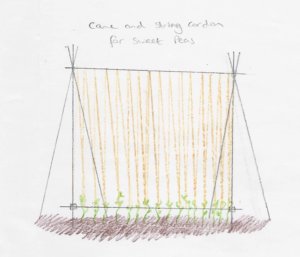
Design for easy-to-make string cordon on cane frame

Tendrils of nearby plants can distort and bend flower stems
I love growing sweet peas on wigwams in an ornamental bed. Bamboo tripods and obelisks create height and structure in a flower bed and when festooned in fragrant sweet peas the effect is undeniably stunning.
However, when I started growing sweet peas in greater quantities for cut flowers I soon discovered the tripod or obelisk structure compromised the quality of the flowers.
Plants on an obselisk grow upwards and inwards, eventually converging at the top in a tangled mess. The ingenious tendrils of the sweet pea reach out and grab whatever they can for support. Where the tendrils wrap around a nearby flower spike, the stem can be bent and curled in the process.
I decided that I would start growing sweet peas in my vegetable patch, and that I needed to attempt to grow each plant more vertically and more widely spaced from its neighbours. It’s possible that it’s been done by others of course, but I developed my own take on a cordon method which I’ve set out below with useful photographs.
If you are trying to decide which varieties to grow for cut flowers you may also be interested to read my article on choosing the perfect bloom for you. Click here for my article on sweet pea varieties including some stunning pictures of my favourites for scent, colour, pattern and even the show bench.
My take on the cordon method – using fewer canes
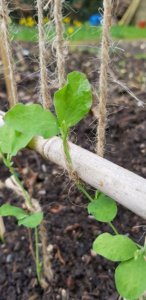
It is easy to twist string around a sweet pea seedling – after which it will grow straight upwards
Professional growers and exhibitors for show tend to grow sweet peas as cordons – straight upwards and usually one plant per bamboo cane. The advantage of this is that each plant can be suitably spaced, won’t interfere with its neighbours and can easily be inspected for spent flowers. The cut flower grower’s enemy is flowers going to pod. Seed-set compromises flower productivity.
As I grow 50 or so plants a year I decided that investment in 50 new individual canes was beyond me, as was the ability to store so many canes.
My solution was to build a structure which used fewer canes and could support vertical strings up which the plants could be trained.
One major advantage of string is that it is very easy to train the plant upwards. Sweet peas are fairly robust, but can bend or even break if roughly handled. Tying stems to canes is fiddly, whereas it is very easy to gently twist a taught string around the growing stem.
What you need
To create each 2.4 metre long section of support frame you will need:
- 8 2.4 metre bamboo canes
- A big ball of gardening string
- Sharp knife or scissors to cut string.
This year, to support 50 plants, I built three 2.4 metre sections, connected together in one long line. This runs along a thin strip in between a line of asparagus and the edge of a raised bed and is an excellent use of a narrow space.
How to build
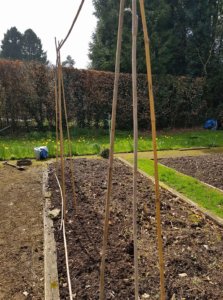
Bamboo tripods set a cane’s length apart
- Start by pushing three bamboo canes straight into the soil in a triangle.
- Gather the the canes together at the top to form a tall tripod. I start with a clove hitch over the top of one cane and then loop the string round each cane in turn a few times before tying the two ends of string back together.
- Lie a cane along the ground from the first tripod to gauge where to site the second tripod and repeat the steps above.
- Sandwich a cane horizontally between the crossing tops of the two tripods. If this is not firmly wedged in place, tie on with string.
- Secure a second cane horizontally just above ground level. This will need lashing to one of the vertical canes of each tripod. I used a method called square-lashing as this is very strong.
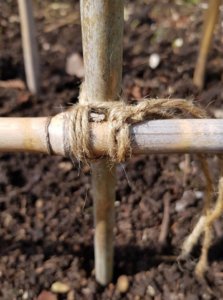
Square lashing is a good technique for securing a horizontal cane to a vertical one
- Take your spool of gardening string and place a pencil through the middle. Secure the end of the spool to the bottom cane at one end of the structure them, holding the pencil at both ends, run the string up and over the top horizontal cane, back to the bottom and continue unspooling to create a zig-zag of string along the length of the structure. Cut the string and secure at the end
- Don’t worry if the strings aren’t fully taught across the length of the structure. It’s difficult to achieve as canes are rarely perfectly straight and it can be difficult to keep the string tentioned. The sweet peas will climb regardless.
How to plant your sweet peas
- Prepare your soil by digging in some homemade compost along the line you want to plant. I added granules of chicken manure too to give the sweet peas extra oomph.
- Space your sweet peas 10-15cm apart along the base of the structure. Dig a deepish hole with a trowel, tease the sweet pea from its pot and plant securely.
- There is usually a gap between the sweet pea and the start of the strings. If this is the case I place a few twigs around the plants to support them until they reach the strings
- Once the sweet pea reaches the string it will probably start climbing up of it’s own accord. If they flop, grab the string just above the growing stem and twist it gently around.
- Once they get established, the sweet peas should need no further help and will scramble upwards giving you a long harvest period of strong straight stems.

Sweet pea ‘Price Edward’ growing strong and straight from a string cordon
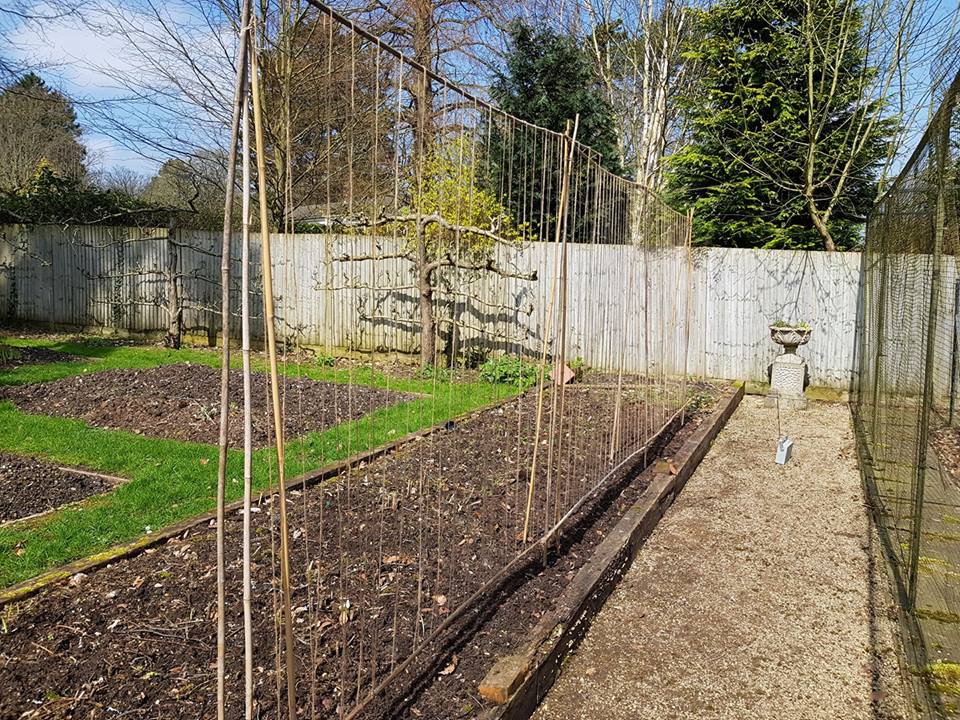


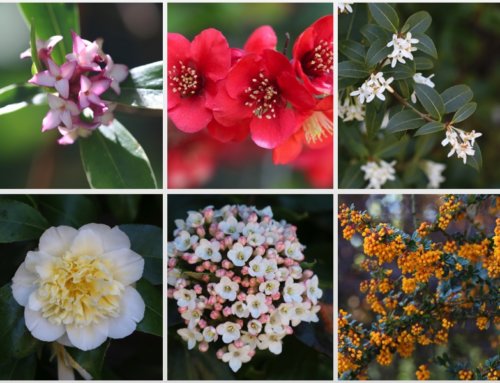
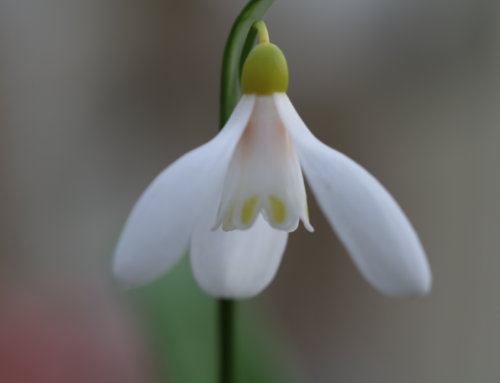
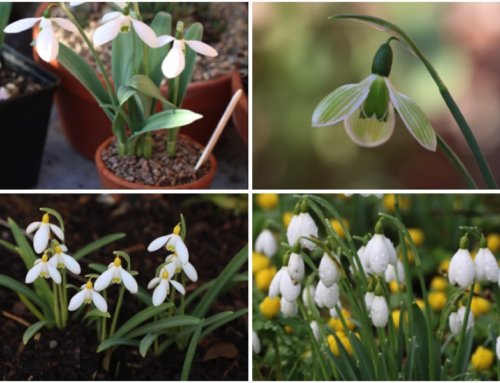
Lovely – and simple – idea! Thanks.
This method looks promising. It is now in place and waiting for the seedlings.
Hi Robin – I really hope it works for you! I’m yet to build mine – a job for the weekend.
Loved this beautifully written post. Clear succinct and a great idea. I’ll be trying it this weekend. Thankyou
Thank you so much for your flattering comments Sian. I really hope it works for you as it does for me. It’s so easy to twist the stems into the string as they grow. No need to keep heading out with string and scissors for laborious tying in sessions. I wish you a sweet pea summer!
Brilliant idea – trying it out for first time but already sweet peas are starting to climb up. For years have struggled with canes or sticks. This was quite easy to build. Cheated a bit and used gorilla tape to hold canes at top together but square lashed the horizontal canes. Also used 1 extra cane on tripod a quad pod!? As can be windy with us. Thank you for the idea.
Hi Hazel, I’m so pleased you’ve given it a go. I like the gorilla tape hack – I presume it’ll cope with UV and rain. I find string can eventually start to degenerate anyway but it certainly lasts longer than the sweet peas. In the first year I did this I used just one cane at each end stuck in the soil. It was a disaster and I had to put up guy ropes to keep the structure upright, hence the tripod innovation. I’m sure the quadropod will work too. Good luck for a summer filled with sweet peas!
This is a really great method my sweet peas are climbing better then they ever had before so thank you ! I now have side shoots do you tie these in as well or do you recommend removing them?
I leave mine as I like lots of flowers. Those growing for show will remove some side shoots to improve the quality of the blooms left behind. I’m so so pleased this has worked for you!
What a brilliant method! I will use it next year instead of netting. I have just ordered my seeds and can’t wait
Hi Miranda, I’m so glad you liked the idea. It works for me every time, and is more attractive and easy to work with than plastic net. Good luck and I hope you get a wonderful crop of sweet peas next year.
This looks brilliant, thank yoolu for sharing and will definitely try this method this year! I did the cordon method on a obelisk last year – removed side shoots and tendrils, and tied it. It took a long time, but the sweet peas were fantastic.
I want to grow in a line like you this year. Do you remove the tendrils? Or not need to because they are spaced far enough apart? Thank you!
Hi Julia – I’ve never bothered to remove the tendrils as I find most of the flowers grow on nice straight stems away from the vine. Some do get mangled out of shape by tendrils so if you’re thinking of showing then it’s worth the effort of removing them. If they’re for cut flowers you’ll probably find most are fine without bothering. Good luck!
I love growing sweet peas, thanks for sharing great tips!
Thanks for the tips! I’ve just spent a worthwhile hour or so putting mine together. I’m using a large rectangle planter on wheels to house the sweet peas this year!
Fingers crossed it works. Will let you know with photos pre and during the growing process.
Just hope the jute strong I’ve used is starting enough?
Hi Trish – how did things do? It’s been a tough summer with all that heat so I’m hoping your sweet peas were ok!
Well, thank you! I have spent all Winter wondering how to squeeze a couple of rows of sweet peas into my already crowded plot ……. and this has provided the solution. The only adaption will be that I intend to fix my vertical canes to the corners at the narrow ends of my raised beds. This, I’m hoping, will secure them well for the horizontal canes and strings.
Well, thank you! I have spent all Winter wondering where to squeeze in a couple of rows of my favourite sweet peas in an already crowded plot …… and your method has provided the solution. The only adaption will be to secure the vertical end canes to the narrow ends of my raised beds before I fix the horizontal canes and strings.